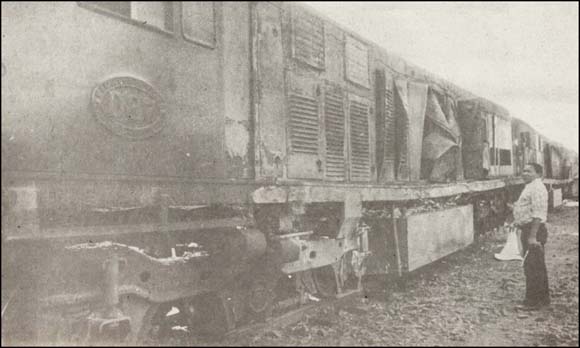The Conflict with Renamo, 1976-1992
«December 1990»
Dossier MZ-0020
![]()




![]()
130. Zimbabwe Troops Withdraw to the Corridors

Above: Rolling stock of the Mozambican railways, CFM, damaged in an MNR/Renamo attack. Ambushing of rail and road traffic was a constantly-used tactic by Renamo throughout the 16-year conflict.
Agreement was reached in December at the peace negotiations in Rome to put a partial cease-fire in place along two of the railway corridors running across Mozambique from its landlocked hinterlands to the Indian Ocean. The signed deal limited the activities of 7,000 ZNA (Zimbabwe National Army) troops who were in Mozambique in combat roles in support of the Frelimo Party government of then President Joaquim Chissano. The previous day the government had adopted a new multi-party constitution, passed by the country's Assembleia da República but without Renamo (or indeed any opposition) participation.
The government was keen to protect the country's rail and road corridors, which were attractive targets both for Renamo units and gangs of armed criminals after easy pickings and plunder. Reports at the time questioned whether Renamo president Afonso Dhlakama in fact exercised sufficiently effective control over his forces to be able to command a halt to sabotage and ambushes along lines of rail.
At the time, some analysts in the Zimbabwean press greeted the cease-fire agreement with enthusiasm, claiming that Renamo was now "on the run" after the ZNA's "massive military campaign". However, Renamo apparently still enjoyed some South African support, and was able to mount raids throughout the month in Matutuine, Nampula, Nhamatanda, and elsewhere. There were also reports in the South African press claiming that Renamo fighters were involved in ongoing violence in Thokoza, in the context of intense Inkatha-ANC rivalry.
![]()
Consolidated Downloadable Zipped Files
Click on the yellow folder image below to download an unsorted zipped archive of documents and press clippings in PDF format concerning the armed conflict between Renamo/MNR and the Mozambican government in December 1990.
![]()



![Aluka: Struggles for Freedom [subscription required] Struggles for Freedom](imgs/aluka_200.png)



